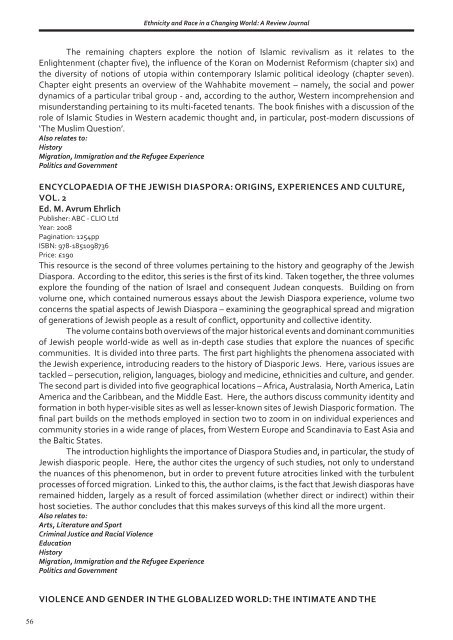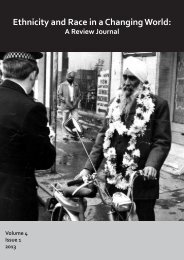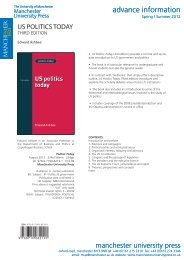Ethnicity and Race in a Changing World
Volume 2, Issue 1, 2010 - Manchester University Press
Volume 2, Issue 1, 2010 - Manchester University Press
- No tags were found...
Create successful ePaper yourself
Turn your PDF publications into a flip-book with our unique Google optimized e-Paper software.
<strong>Ethnicity</strong> <strong>and</strong> <strong>Race</strong> <strong>in</strong> a Chang<strong>in</strong>g <strong>World</strong>: A Review JournalThe rema<strong>in</strong><strong>in</strong>g chapters explore the notion of Islamic revivalism as it relates to theEnlightenment (chapter five), the <strong>in</strong>fluence of the Koran on Modernist Reformism (chapter six) <strong>and</strong>the diversity of notions of utopia with<strong>in</strong> contemporary Islamic political ideology (chapter seven).Chapter eight presents an overview of the Wahhabite movement – namely, the social <strong>and</strong> powerdynamics of a particular tribal group - <strong>and</strong>, accord<strong>in</strong>g to the author, Western <strong>in</strong>comprehension <strong>and</strong>misunderst<strong>and</strong><strong>in</strong>g perta<strong>in</strong><strong>in</strong>g to its multi-faceted tenants. The book f<strong>in</strong>ishes with a discussion of therole of Islamic Studies <strong>in</strong> Western academic thought <strong>and</strong>, <strong>in</strong> particular, post-modern discussions of‘The Muslim Question’.Also relates to:HistoryMigration, Immigration <strong>and</strong> the Refugee ExperiencePolitics <strong>and</strong> GovernmentENCYCLOPAEDIA OF THE JEWISH DIASPORA: ORIGINS, EXPERIENCES AND CULTURE,VOL. 2Ed. M. Avrum EhrlichPublisher: ABC - CLIO LtdYear: 2008Pag<strong>in</strong>ation: 1254ppISBN: 978-1851098736Price: £190This resource is the second of three volumes perta<strong>in</strong><strong>in</strong>g to the history <strong>and</strong> geography of the JewishDiaspora. Accord<strong>in</strong>g to the editor, this series is the first of its k<strong>in</strong>d. Taken together, the three volumesexplore the found<strong>in</strong>g of the nation of Israel <strong>and</strong> consequent Judean conquests. Build<strong>in</strong>g on fromvolume one, which conta<strong>in</strong>ed numerous essays about the Jewish Diaspora experience, volume twoconcerns the spatial aspects of Jewish Diaspora – exam<strong>in</strong><strong>in</strong>g the geographical spread <strong>and</strong> migrationof generations of Jewish people as a result of conflict, opportunity <strong>and</strong> collective identity.The volume conta<strong>in</strong>s both overviews of the major historical events <strong>and</strong> dom<strong>in</strong>ant communitiesof Jewish people world-wide as well as <strong>in</strong>-depth case studies that explore the nuances of specificcommunities. It is divided <strong>in</strong>to three parts. The first part highlights the phenomena associated withthe Jewish experience, <strong>in</strong>troduc<strong>in</strong>g readers to the history of Diasporic Jews. Here, various issues aretackled – persecution, religion, languages, biology <strong>and</strong> medic<strong>in</strong>e, ethnicities <strong>and</strong> culture, <strong>and</strong> gender.The second part is divided <strong>in</strong>to five geographical locations – Africa, Australasia, North America, Lat<strong>in</strong>America <strong>and</strong> the Caribbean, <strong>and</strong> the Middle East. Here, the authors discuss community identity <strong>and</strong>formation <strong>in</strong> both hyper-visible sites as well as lesser-known sites of Jewish Diasporic formation. Thef<strong>in</strong>al part builds on the methods employed <strong>in</strong> section two to zoom <strong>in</strong> on <strong>in</strong>dividual experiences <strong>and</strong>community stories <strong>in</strong> a wide range of places, from Western Europe <strong>and</strong> Sc<strong>and</strong><strong>in</strong>avia to East Asia <strong>and</strong>the Baltic States.The <strong>in</strong>troduction highlights the importance of Diaspora Studies <strong>and</strong>, <strong>in</strong> particular, the study ofJewish diasporic people. Here, the author cites the urgency of such studies, not only to underst<strong>and</strong>the nuances of this phenomenon, but <strong>in</strong> order to prevent future atrocities l<strong>in</strong>ked with the turbulentprocesses of forced migration. L<strong>in</strong>ked to this, the author claims, is the fact that Jewish diasporas haverema<strong>in</strong>ed hidden, largely as a result of forced assimilation (whether direct or <strong>in</strong>direct) with<strong>in</strong> theirhost societies. The author concludes that this makes surveys of this k<strong>in</strong>d all the more urgent.Also relates to:Arts, Literature <strong>and</strong> SportCrim<strong>in</strong>al Justice <strong>and</strong> Racial ViolenceEducationHistoryMigration, Immigration <strong>and</strong> the Refugee ExperiencePolitics <strong>and</strong> GovernmentVIOLENCE AND GENDER IN THE GLOBALIZED WORLD: THE INTIMATE AND THE56






